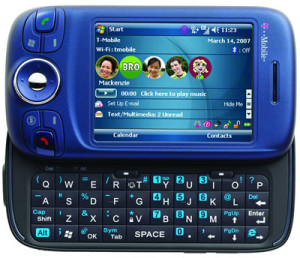I mentioned a few weeks ago that I want some sort of mobile internet access for San Diego Comic-Con so that I can post at least some stuff from the convention itself, instead of waiting until I get back to the hotel. Since the con has never offered wi-fi (except, IIRC, in the press room — which I just realized I could have used last year, since I got a press badge for CBR/Comics Should Be Good), I was looking into phone-based solutions.
Phoning it In
I experimented with post-by-email (not sufficient), with post-through-Flickr (slightly better, but only really suitable for image posts and still missing things like, oh, titles), and with using WPhone to provide a stripped-down admin interface in the hopes that my phone’s built-in browser could handle it (no such luck). No, I was clearly going to need a better web browser — one way or another.
 Yesterday I went into a T-Mobile store, partly to look at the smartphones they had, and partly to ask about what data plan would allow me to use Opera Mini on my current phone. The guy tried to sell me a Blackberry, but I have to admit the Wing looked really nice, if expensive.
Yesterday I went into a T-Mobile store, partly to look at the smartphones they had, and partly to ask about what data plan would allow me to use Opera Mini on my current phone. The guy tried to sell me a Blackberry, but I have to admit the Wing looked really nice, if expensive.
 I asked about getting the Internet plan, and while the sales clerk was familiar with Opera Mini (he uses it on his own Blackberry), he was convinced it wouldn’t run on my RAZR V3t. I’d used an early version of it during a brief window in which T-Mobile allowed access even for phones with the T-Zones plan. But he seemed convinced there would be no point, so I walked out without having changed anything. 30 seconds of Internet searching reveals that yes, Opera Mini is in fact known to work on the RAZR V3t.
I asked about getting the Internet plan, and while the sales clerk was familiar with Opera Mini (he uses it on his own Blackberry), he was convinced it wouldn’t run on my RAZR V3t. I’d used an early version of it during a brief window in which T-Mobile allowed access even for phones with the T-Zones plan. But he seemed convinced there would be no point, so I walked out without having changed anything. 30 seconds of Internet searching reveals that yes, Opera Mini is in fact known to work on the RAZR V3t.
Free WiFi
Today, the news started making the rounds that the con will have free wi-fi everywhere except the exhibit hall itself, sponsored by the film, Eagle Eye. (Which, now that I think about it, is oddly appropriate and somewhat disturbing.) This is a huge relief, and makes the phone access much less critical. Though it would still be nice…
Sure, it’s going to be a very busy network. But I figure I’ll type things up in TextWrangler and load up the web just long enough to post. Gears will cut down on the amount of bandwidth needed for the admin interface. And I’ll save any serious emailing or forum visits for the hotel room. Actually, I’ll probably stay off the forums during most of the con, unless I have the opportunity to post “Hey, look what I just found out!”